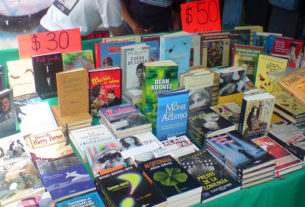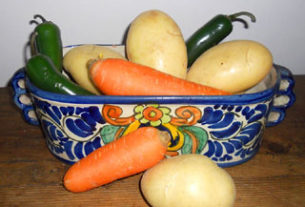Mexican Kitchen
Last month, the nixtamalization of corn dough – or masa – was discussed, along with a description of the process itself and detailed instructions for making masa at home, either from scratch with dried corn, or using masa harina mix. Now comes the fun part: the many different regional treats that can be made with this basic tortilla dough. For although the tortilla is eaten as an accompaniment to most meals, it is also the basis of many of the delicious snack foods – antojitos and botanas – prepared all over Mexico.
Sometimes, traveling around the country, it seems that the possible variations on the tortilla theme are endless. The size and thickness of the tortillas themselves, plus the incredible array of food which is served on, in, and under them, varies from one state to another. The chalupas and molotes of Puebla, the salbutes and panuchos of the Yucatan, Oaxaca’s entomatadas, enfrijoladas, enmoladas and tlayudas are just a few of the delicious regional specialties based on simple tortillas. Tacos, of course, are found everywhere, with local variations on fillings.
Quesadillas, while not quite as widespread as the ubiquitous taco, are sold from street stands all over the central part of the country. Cheese, shredded meat, chorizo, squash blossoms, chiles and mushrooms are all common quesadilla fillings in the high central plateau. They are most frequently prepared on a dry comal, but may also be fried.
Whether filling tortillas to make quesadillas, enchiladas or flautas, or just rolling one around some of the food on your plate to make an impomptu taco, always put the food on the inside, or pancita – “belly” – of the taco. This is the thinner side, which puffs up when the tortilla is being baked on the comal. The thicker side is called the espalada, or “back.” This bit of information is more than just “tortilla etiquette”, but a very practical point, because if the thinner part of the tortilla ends up on the outside, it will be much more likely to fall apart.
Before sharing some regional recipes, a word about color: Corn tortillas usually range in color from a lemony yellow to nearly white, depending upon the color of the corn kernels used. Contrary to some foreigners’ belief that the darker yellow ones are somehow more nutritious, it has been pointed out by Mexican friends that this deep color is often a result of using too much cal (calcium hydroxide ) in the nixtamalization process, which also tends to give the tortillas a somewhat sour taste. Blue corn tortillas, made with dark bluish-green kernels, are sometimes sold, handmade, in the markets of central Mexico. Pinkish-red ones, made from the deep red-purple kernels, are much less common, although food coloring is sometimes added to masa for special occasions. Tortillas and “chips” made with bright vegetable colors or food coloring have recently become available in upscale supermarkets in both the US and Mexico, and make very attractive serving presentations.
All of these descriptions apply only to corn tortillas. Flour tortillas, made with refined white flour instead of corn masa, are a specialty of northern Mexico and the border region. They are far less common further south, and will be discussed in an upcoming article on norteño cooking. Meanwhile, whether recapturing the flavors of a Mexican journey, or just doing some armchair traveling, try some of these authentic regional specialties and celebrate patriotic September, el mes de la patria.
- Chalupas Poblanas: Puebla-Style Chalupas
- Salbutes Yucatecos: Yucatecan Salbutes
- Entomatadas Oaxaqueñas: Tortillas in Oaxacan Tomato Sauce
- Picaditas Veracruzanas: Veracruz-Style Picaditas with Black Beans and Salsa


